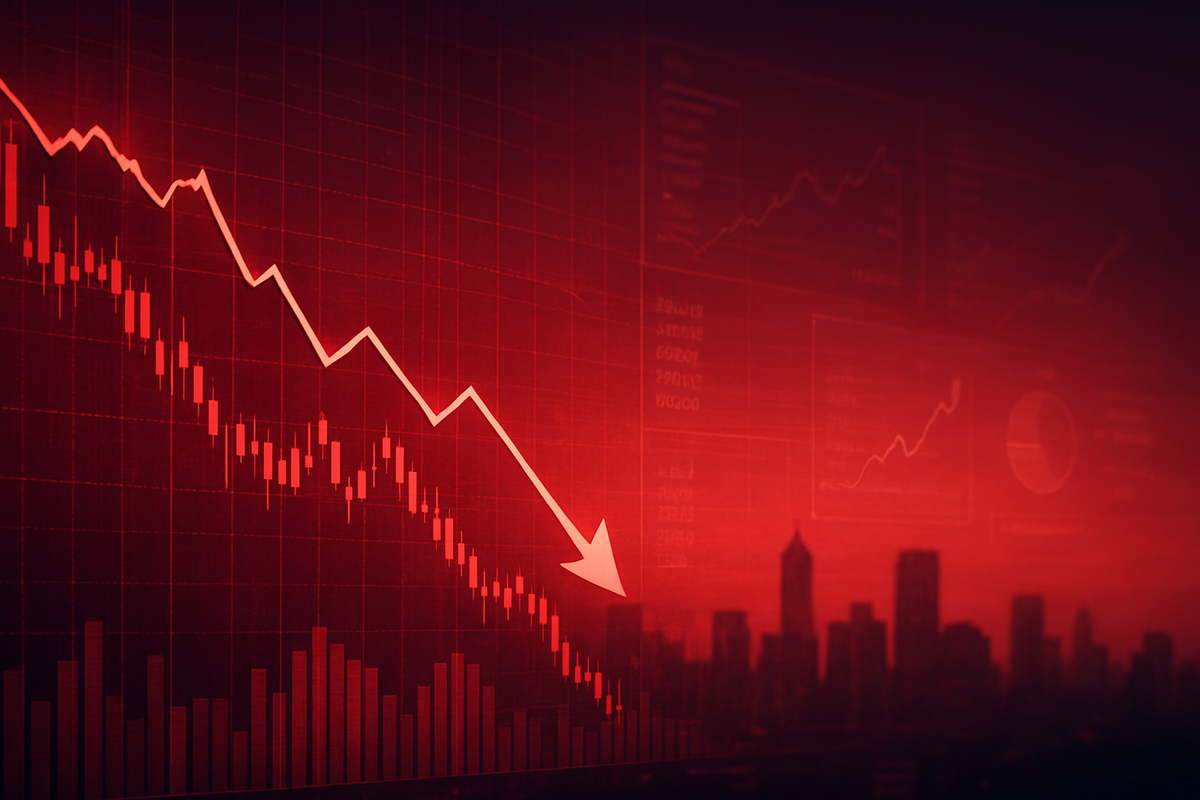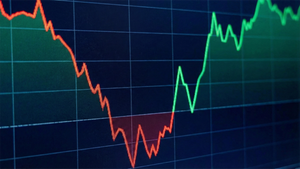
The financial markets are grappling with the reverberations of a significant day of declines, leaving investors and analysts alike pondering the immediate and long-term trajectory. This recent downturn has injected a fresh wave of uncertainty, prompting a re-evaluation of investment strategies and a heightened focus on key economic indicators. As the dust settles, the prevailing sentiment is a mix of caution and strategic opportunism, with market participants closely monitoring signals that could dictate the next phase of market activity.
The immediate implications of such a sharp correction are palpable. Volatility has surged, and investor sentiment has visibly shifted towards a more bearish outlook. While some investors are gripped by the fear of further losses, leading to potential panic selling, others view the current environment as a crucial buying opportunity, especially for high-quality assets now trading at reduced valuations. This divergence in approach highlights the psychological battle inherent in market downturns, where long-term conviction is tested against short-term anxieties.
Unpacking the Recent Market Retreat
The recent day of significant market declines was characterized by a broad-based sell-off across major indices, including the Dow Jones Industrial Average (DJIA), S&P 500 (SPX), and Nasdaq Composite (IXIC). This downturn was not an isolated event but rather the culmination of several underlying pressures that have been building in the market. While specific triggers can vary, common catalysts include hawkish signals from central banks regarding interest rate policies, disappointing corporate earnings reports from bellwether companies, and escalating geopolitical tensions that fuel global economic uncertainty.
Leading up to this moment, a timeline of events often reveals a gradual erosion of investor confidence. For instance, concerns over persistent inflation coupled with a firm stance from the Federal Reserve (FED) on maintaining higher interest rates for longer can steadily dampen market enthusiasm. This might be compounded by a series of less-than-stellar economic data releases, such as weaker manufacturing output or a slowdown in consumer spending. Key players involved in shaping this narrative include central bank officials, who communicate monetary policy, and corporate executives, whose earnings guidance can send shockwaves through their respective sectors. Initial market reactions typically involve a rapid shedding of risk assets, with technology and growth stocks often experiencing the sharpest corrections due to their higher valuations.
The immediate aftermath saw a pronounced shift in trading patterns. Volume often increases during significant sell-offs as both institutional and retail investors adjust their portfolios. Specific sectors, particularly those sensitive to economic cycles or interest rates, tend to bear the brunt of the selling pressure. For example, if the decline is driven by inflation fears, consumer discretionary companies might see significant drops, while if it's due to interest rate hikes, sectors reliant on borrowing, such as real estate, could suffer. This widespread reaction underscores the interconnectedness of the global financial system and how swiftly negative sentiment can propagate across different asset classes and geographies.
Corporate Fortunes: Winners and Losers in a Volatile Market
Market downturns inevitably create a clear delineation between companies that are resilient and those that are vulnerable. In the wake of a significant decline, certain sectors and individual companies are positioned to either weather the storm more effectively or face considerable headwinds. Generally, defensive sectors tend to outperform during periods of market volatility. These include consumer staples, healthcare, and utilities, whose products and services remain essential regardless of economic conditions. Companies like Procter & Gamble (NYSE: PG), Johnson & Johnson (NYSE: JNJ), and Duke Energy (NYSE: DUK) often see their stocks hold up better as investors flock to their stable earnings and reliable dividends.
Conversely, growth-oriented companies, particularly those in the technology and discretionary sectors, often experience the sharpest declines. Companies such as NVIDIA (NASDAQ: NVDA), Tesla (NASDAQ: TSLA), or Amazon (NASDAQ: AMZN), while having strong long-term prospects, are more sensitive to investor sentiment and higher interest rates which can discount their future earnings more heavily. High-valuation stocks, especially those that have seen significant appreciation without corresponding fundamental growth, are particularly susceptible to corrections as investors become more risk-averse and demand a higher premium for future potential.
Beyond sector-wide trends, individual company fundamentals play a crucial role. Companies with strong balance sheets, healthy cash flows, and manageable debt levels are better equipped to navigate economic uncertainties. They may even find opportunities to acquire distressed competitors or invest in growth initiatives at lower costs. In contrast, highly leveraged companies or those dependent on continuous access to capital markets for funding can face severe challenges as credit tightens and investor confidence wanes, potentially impacting their ability to finance operations or expansion plans.
Broader Implications and Historical Context
The recent market decline is not an isolated incident but rather fits into broader industry trends, particularly the ongoing recalibration of monetary policy and the persistent concerns over global economic stability. The era of ultra-low interest rates and abundant liquidity, which fueled significant market gains for over a decade, is gradually giving way to a more restrictive environment. This shift forces a re-evaluation of asset valuations and corporate profitability, especially for companies that thrived on cheap capital. The event could accelerate a trend towards value investing over pure growth, as investors prioritize companies with strong current earnings and robust business models.
The ripple effects of such a market event can be far-reaching, impacting competitors, partners, and even the broader economy. Competitors in less resilient sectors might face increased pressure, potentially leading to consolidation or bankruptcies. Supply chain partners could experience disruptions if key clients scale back operations or face financial difficulties. Furthermore, a significant market downturn can have regulatory or policy implications, potentially prompting governments and central banks to consider interventions, such as adjusting interest rates, implementing stimulus measures, or introducing new regulations to stabilize financial markets and protect investors.
Historically, market corrections are a normal and often healthy part of the economic cycle. Comparisons can be drawn to periods like the dot-com bubble burst in the early 2000s, the 2008 financial crisis, or even the shorter, sharper corrections seen in 2018 or early 2020. Each event, while unique in its triggers, shared common characteristics: an initial shock, widespread investor panic, and eventually, a period of recovery driven by underlying economic fundamentals and policy responses. Understanding these historical precedents helps contextualize the current situation, reminding investors that downturns, while painful, are typically followed by rebounds, albeit on an unpredictable timeline.
Navigating the Path Forward: What Comes Next
Looking ahead, the market faces a period of heightened scrutiny and potential strategic shifts. In the short term, volatility is likely to persist as investors digest incoming economic data, corporate earnings, and any further communications from central banks. We could see continued sector rotation, with money flowing out of speculative assets and into more defensive or value-oriented stocks. Short-term possibilities also include further re-testing of recent lows, as well as intermittent relief rallies driven by technical factors or temporary positive news. Investors should brace for a choppy market, where quick reversals are possible.
In the long term, the market's trajectory will largely depend on the interplay of inflation, interest rates, and corporate profitability. If inflation begins to consistently trend downwards, it could pave the way for central banks to ease monetary policy, providing a significant tailwind for equities. Conversely, persistent inflation could necessitate further tightening, prolonging the period of market uncertainty. Companies will need to adapt strategically, focusing on cost efficiencies, strengthening balance sheets, and innovating to maintain competitive advantages. This environment may favor companies with strong pricing power and those less reliant on external financing.
Market opportunities may emerge in overlooked sectors or undervalued companies that have been unfairly punished in the broader sell-off. Disruptive technologies, even if initially hit hard, could present compelling long-term buying opportunities for patient investors. Challenges will include navigating a potentially slower global growth environment and managing increased regulatory oversight. Potential scenarios range from a relatively quick V-shaped recovery, driven by a swift resolution of current economic headwinds, to a more prolonged U-shaped recovery, characterized by a longer period of stagnation before a sustained upturn. A less favorable L-shaped outcome, though less common, would involve a significant downturn followed by a prolonged period of suppressed growth.
Comprehensive Wrap-up and Investor Outlook
In summary, the recent day of market declines serves as a critical reminder of the inherent volatility and cyclical nature of financial markets. Key takeaways include the immediate impact on investor sentiment, the differentiation between resilient and vulnerable companies, and the broader economic and policy implications. This event underscores the importance of a well-diversified portfolio and a long-term investment horizon, as emotional reactions during downturns often lead to suboptimal outcomes.
Moving forward, the market will likely be characterized by continued uncertainty but also by emerging opportunities for discerning investors. The prevailing narrative will revolve around the trajectory of inflation, the future path of interest rates, and the resilience of corporate earnings. These factors will collectively determine the market's ability to regain its footing and embark on a sustained recovery. The current environment necessitates a cautious yet strategic approach, emphasizing fundamental analysis over speculative bets.
Investors should closely watch several key indicators in the coming months: inflation data, particularly the Consumer Price Index (CPI) and Producer Price Index (PPI); central bank statements and meeting minutes for clues on monetary policy; corporate earnings reports for insights into business health; and geopolitical developments that could impact global trade and economic stability. Understanding these signals will be crucial for navigating the evolving market landscape and making informed investment decisions in the wake of recent declines.
This content is intended for informational purposes only and is not financial advice






